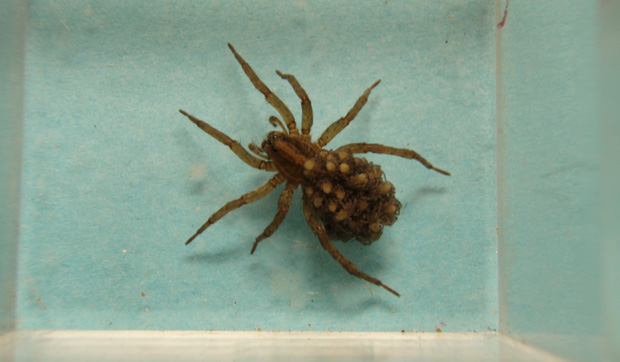Briefly detained in the name of science, this female wolf spider displays a distinctive Lycosidae behavior: carrying her brood upon her back.
Good Natured: Itsy Bitsy Wolf Spiders
September 15, 2023
We’re probably all familiar with the saga of the Itsy Bitsy Spider–how, amid a sudden weather shift, the wee beastie suffered a severe setback during its journey up a water spout. Lesser creatures might have drowned, but this arachnid was able to survive thanks to a naturally low metabolism and thus very low rate of oxygen consumption. Perhaps a bit moist but otherwise unharmed, it resumed its trek once the sun came out again. Yay!
I don’t know about you, but these past few weeks I’ve been seeing all sorts of itsy-bitsy spiders, many in states of peril similar to their famous predecessor: floating in the bird bath; ascending the shower curtain; rappelling off the kitchen faucet, heading toward the drain.
I’ve tried to identify these teeny-weeny arachnids but, doggone it, they have defied even my best efforts. A lot of spider identification relies on things like eye arrangement and specific features on the reproductive organs-attributes that can be tough to see on an adult spider, let alone a munchkin measuring a millimeter in length. Myopic and clumsy me has struggled mightily to make sense of what few parts I can discern under a hand lens, but I’ve come up empty. Every. Single. Time.
Until the other day.
I was outside of Good Natured World Headquarters, admiring the wealth of acorns our magnificent bur oak produced this year. Wanting a closer look at the fuzzy cupules, or acorn caps, the species is known for, I knelt down to pick up a few choice specimens.
And that’s when I saw her. Er, them. Or, actually, her with them.
Well camouflaged amid the woodchips, dry leaves and assorted acorn bits, a female spider crouched, stock still, her abdomen covered with dozens of itsy-bitsy spiders readily identifiable as her own offspring. And because in our area we have just one group of spiders that carries their broods thusly, it wasn’t hard to ID this blessed creature. She was, without a doubt, a wolf spider.
Now before you start weeping tears of joy over the discovery of this classification windfall, I’ll quickly point out that beyond “wolfie” I wasn’t-and still am not-entirely sure which species she is. The wolf spider family, Lycosidae, contains around 240 North American species and over 50 of these can be found in Illinois.
(How’s this for a fun aside: Although scientific names can hard to pronounce and, occasionally, overwhelming, they always yield clues as to the organism’s dominant ID trait(s). Lycosidae, for example, is derived from the Greek word lycosa, which means wolf, and refers to the spiders’ wolf-like ways of pursuing prey. This trend continues in the names of the genera in the family, with several derived from ancient Greek words for familiar carnivores: Alopecosa comes from alopex, or fox; Arctosa is derived from arctos, or bear; Pardosa, from pardos, the pan-beast or panther; and Tigrosa, from tigri, or tiger.)
(More fun! When a few Asian species of Pardosa were found to differ significantly from their kin, scientists awarded them the genus name Draposa. Is drapos yet another fierce beast named by the Greeks? Nah. Draposa is simply an anagram of Pardosa.)
Let’s see, where were we? Ah yes, the female wolfie and her sweet itsy-bitsy spiderlings, which spider fanciers call slings…
These young wolves emerged from an egg sac that Momma had attached with silk to her behind and dutifully lugged around for weeks on end. When hatching was imminent, she helped the slings open the silken case and then waited as they scurried aboard her back. The first out quickly clung to specially knobbed setae, or hairs, on Mom’s abdomen while subsequent arrivals grabbed onto their siblings; since then they’ve hung on like so many interlocked monkeys in a barrel, living off the remnants of their yolk sacs and waiting for the right time-a week or so is about right–to let go and disperse.
We’ve written about this dispersal in the past, a fascinating process known as ballooning. It’s not a wolf exclusive; the slings of pretty much all spider species balloon their way to their next life stage. An itsy bitsy aims its abdomen skyward and lets loose a long strand of silk. Caught by a breeze or, on still days, electrostatic currents, the little sling lofts up, up and away.
Depending on prevailing conditions and a healthy dose of luck, the itsy bitsy spinder will land feet, yards or miles away to begin its independent life in a new habitat-a woodland, a prairie, a wetland, a water spout. There it might anticipate a long and fruitful life, as long as it can avoid unexpected weather events…and curious naturalists…
Pam Otto is the outreach ambassador for the St. Charles Park District. She can be reached at potto@stcparks.org.

